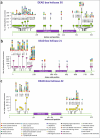Role of DEAD/DEAH-box helicases in immunity, infection and cancers
- PMID: 40537811
- PMCID: PMC12178073
- DOI: 10.1186/s12964-025-02225-9
Role of DEAD/DEAH-box helicases in immunity, infection and cancers
Abstract
DEAD/DEAH-box helicases (DDX) are integral RNA-binding proteins within the RNA helicase superfamily 2 (SF2), characterized by distinct DEAD (Asp-Glu-Ala-Asp) and DEAH (Asp-Glu-Ala-His) motifs. These motifs delineate two subfamilies: DEAD-box (DDX) and DEAH-box (DHX). DEAD-box proteins predominantly facilitate localized non-processive RNA duplex destabilization, whereas DEAH-box helicases mediate processive RNA translocation and unwinding. This functional dichotomy is attributed to Asp-to-His substitution in the DEAH motif, which modulates ATP hydrolysis and conformational dynamics. DEAD-box helicases have been implicated in critical cellular processes, including translation, splicing, and RNA decay. In contrast, DEAH-box proteins play pivotal roles in splicing, ribosome biogenesis, and RNA export. DEAD/DEAH-box helicases play crucial roles in various cellular processes, and their regulation is primarily governed by post-translational modifications (PTMs) and protein-protein interactions (PPIs), particularly within their N- and C-terminal sequences. Despite extensive research, significant knowledge gaps persist regarding their regulation, cofactor roles, substrates, PPIs, mutation effects, and involvement in signaling cascades. Mutations in DEAD domains have been associated with dysregulated immune signaling and have been implicated in various cancers, underscoring their importance in disease pathogenesis. Specific helicases, including DDX3, DDX5, DDX6, and DDX41, have been extensively studied for their roles in immune response regulation, antiviral defense, and cellular stress response. This review critically examines the DEAD-box helicases involved in cell cycle regulation and their inhibitors, as well as those that regulate the Toll-like receptor signaling pathway. Furthermore, we provide comprehensive insights into the phosphorylation-based regulation of major DDX members, with a particular focus on DDX3X, DDX21, and DDX42 in various cancers. Elucidating the molecular mechanisms, regulatory influences, and therapeutic potential of DEAD/DEAH-box helicases is of paramount importance, particularly in the fields of infectious diseases and immune modulation. This review provides current knowledge and identifies critical areas for future research, aiming to advance our understanding of these essential molecular machines and their potential as therapeutic targets.
Keywords: DEAD-box helicases; Immune responses; Post-translational modifications; Protein–protein interactions; RNA helicases; TLR signaling pathway.
© 2025. The Author(s).
Conflict of interest statement
Declarations. Competing interests: The authors declare no competing interests.
Figures





Similar articles
-
Unraveling the mechanism of RNA duplex unwinding by DEAD-box helicase DDX3X: Insights into Cooperativity and roles of protomers.Biochem Biophys Res Commun. 2025 Sep 1;777:152206. doi: 10.1016/j.bbrc.2025.152206. Epub 2025 Jun 13. Biochem Biophys Res Commun. 2025. PMID: 40578281
-
In vitro characterization of the yeast DEAH/RHA RNA helicase Dhr1.J Biol Chem. 2025 Apr;301(4):108366. doi: 10.1016/j.jbc.2025.108366. Epub 2025 Feb 28. J Biol Chem. 2025. PMID: 40024476 Free PMC article.
-
A MicroRNA Screen Identifies the Wnt Signaling Pathway as a Regulator of the Interferon Response during Flavivirus Infection.J Virol. 2017 Mar 29;91(8):e02388-16. doi: 10.1128/JVI.02388-16. Print 2017 Apr 15. J Virol. 2017. PMID: 28148804 Free PMC article.
-
Factors that influence parents' and informal caregivers' views and practices regarding routine childhood vaccination: a qualitative evidence synthesis.Cochrane Database Syst Rev. 2021 Oct 27;10(10):CD013265. doi: 10.1002/14651858.CD013265.pub2. Cochrane Database Syst Rev. 2021. PMID: 34706066 Free PMC article.
-
The use of Open Dialogue in Trauma Informed Care services for mental health consumers and their family networks: A scoping review.J Psychiatr Ment Health Nurs. 2024 Aug;31(4):681-698. doi: 10.1111/jpm.13023. Epub 2024 Jan 17. J Psychiatr Ment Health Nurs. 2024. PMID: 38230967
References
-
- Linder P, Lasko PF, Ashburner M, et al. Birth of the D-E-A-D box. Nature. 1989;337(6203):121–2. - PubMed
-
- Cordin O, Banroques J, Tanner NK, Linder P. The DEAD-box protein family of RNA helicases. Gene. 2006;367:17–37. - PubMed
-
- Tanner NK, Linder P. DExD/H box RNA helicases: from generic motors to specific dissociation functions. Mol Cell. 2001;8(2):251–62. - PubMed
Publication types
MeSH terms
Substances
LinkOut - more resources
Full Text Sources
Medical
Miscellaneous

